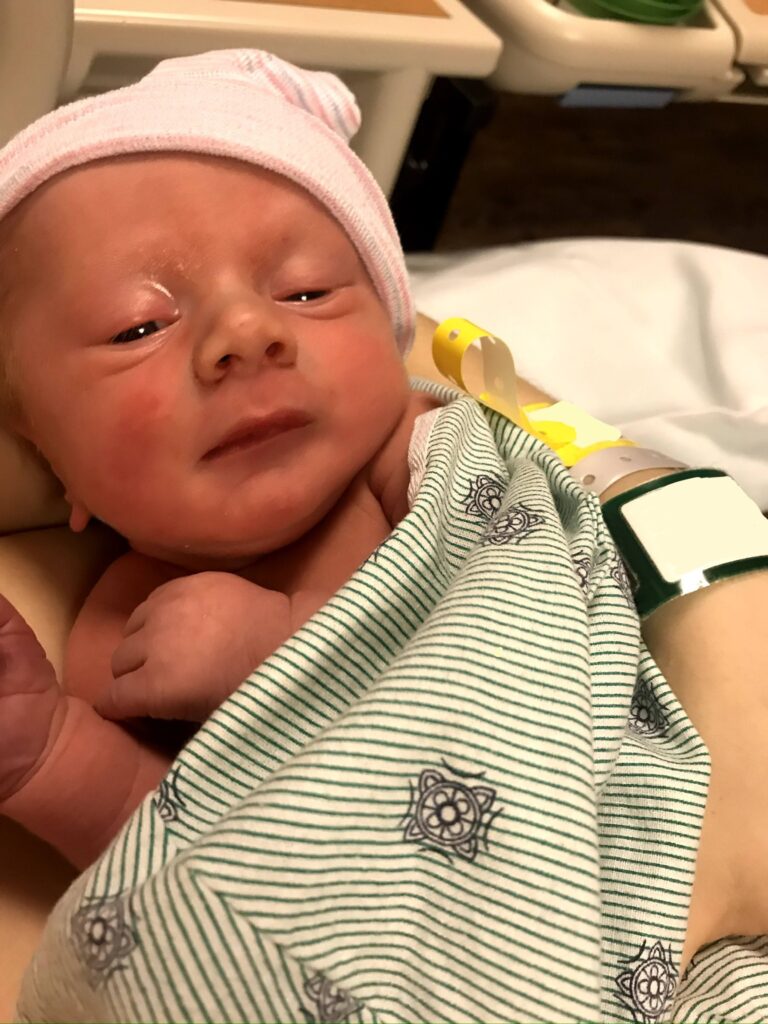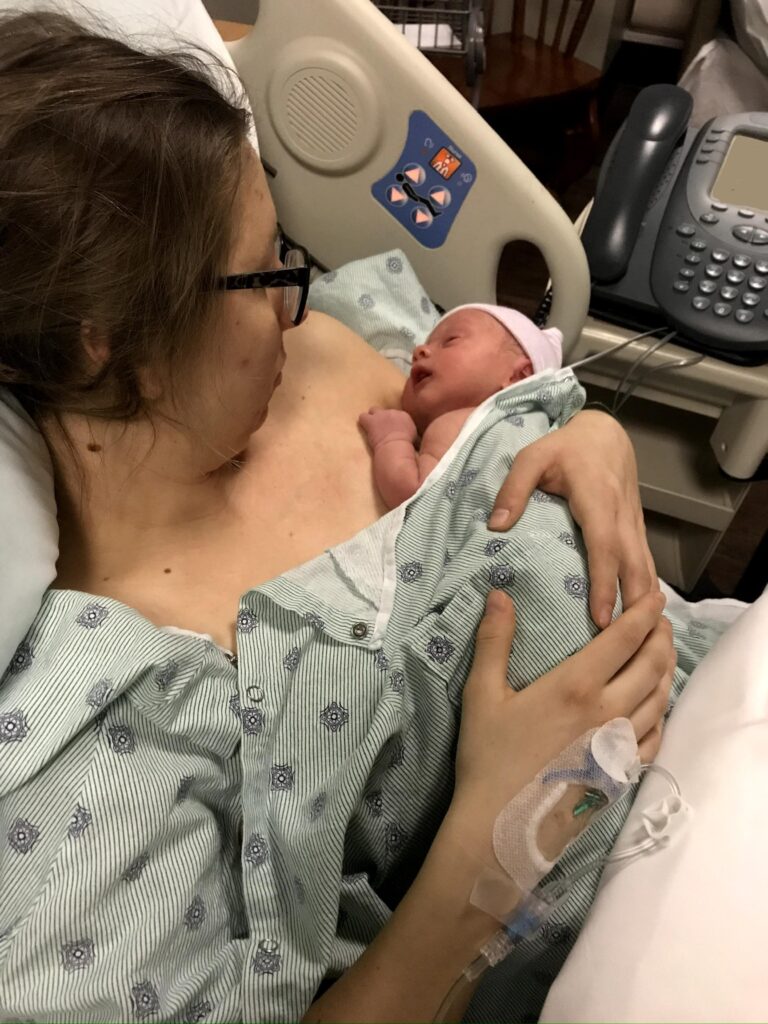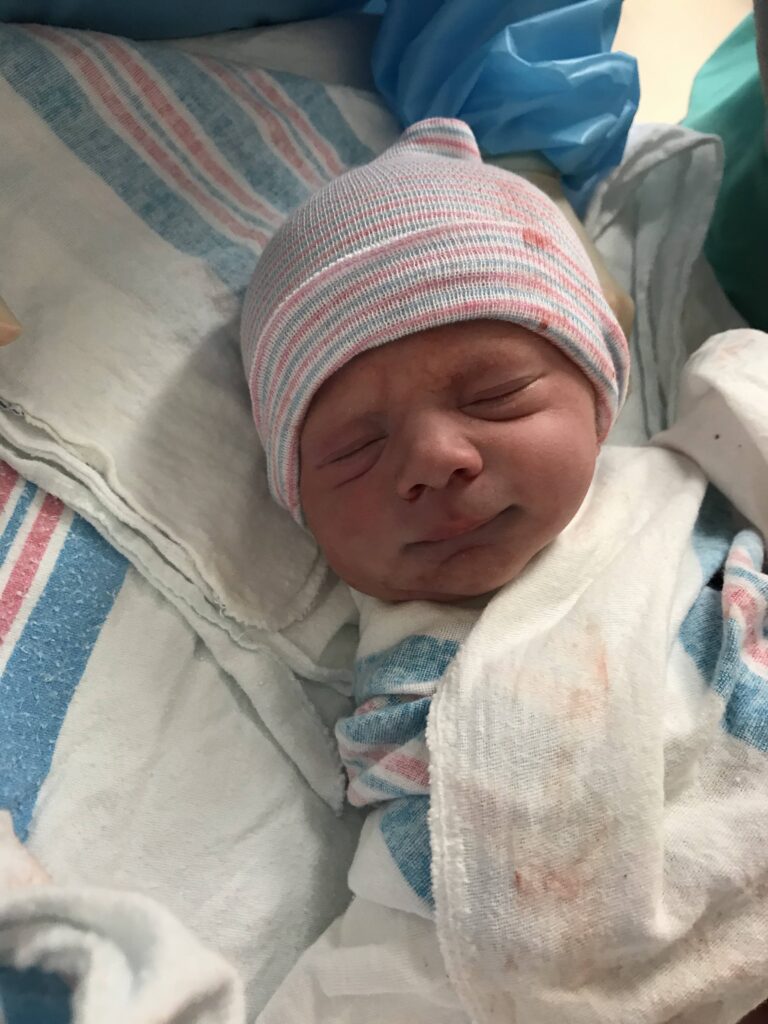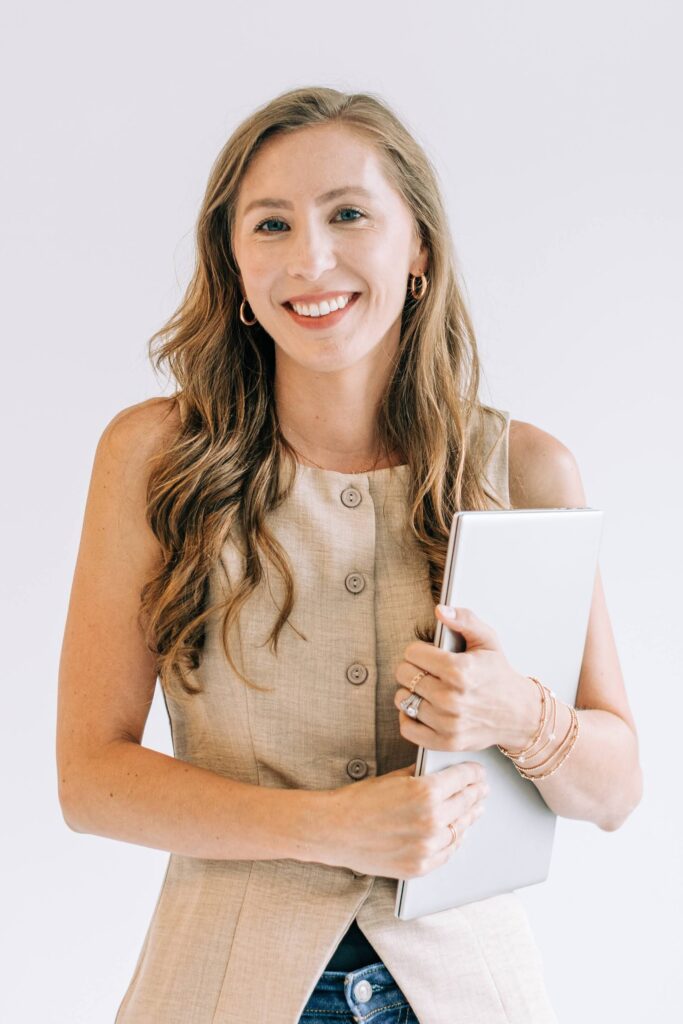______________________________________________________________________



My First C-Section Story
It has taken me years – literally – to finally sit down and write up my c-section stories.
My first c-section was traumatic and I still grieve over what I thought my first birthing experience would be like. My second c-section was the redemptive birthing experience I had prayed for, and I want to share both of these experiences with you.
I hope that sharing my stories can help other mommas feel more prepared for a scheduled c-section if that is the path you need or are opting to take. This is a no-judgment zone, and I believe the best birthing experience is the one where the mother feels advocated for and respected no matter what the mode of delivery was/is (vaginal versus c-section, natural versus epidural, etc).
My Diagnosis
Throughout my entire first pregnancy, we were told that Sullivan was breech. He never moved from that position that we know of, so I was mentally prepped and prepared for a c-section from early on in my pregnancy.
I had been diagnosed with a Bicornuate Uterus, and they believe that is why all my babies are breech as well as why I have subchorionic hematomas in all of my pregnancies (will talk more about this in another blog post). My healthcare provider was not receptive to trying any type of flipping techniques for my babies due to my bicornuate uterus which can increase the risk of complications – this was not a risk I was receptive to taking either.
Preparation For C-Section
I can be completely honest with the fact that I was not prepared for what a c-section entailed. I truly believe moms need to be offered a “cesarean delivery class” or some type of preparation so you know what to expect, including what medications they will give you before the surgery, where baby will be taken while you are in surgery, etc.
I did a birthing and breastfeeding class prior to delivery but many of those classes are geared towards mothers who are having a vaginal delivery. I also didn’t have many requests for my birthing process because I assumed the doctors and nurses knew best and would guide me on optimal newborn practices. I was slightly wrong. This is not to discredit healthcare practitioners (I am one!), but it is to encourage mothers to advocate for what we know is evidence-based and best for our babies, even if it sometimes goes against what medical practitioners are recommending.
Sullivan’s Delivery
Now that we have a little background, here is how it went down with Sullivan’s delivery. We were scheduled to deliver on a Monday morning around 7am, but Sullivan had different plans for us. On Saturday evening before our scheduled c-section, I had just finished eating an excessive amount of wasabi almonds (I am not sure what the thought process was there) and Chris had just gotten off a 12 hour shift at the hospital. We were both super exhausted and fell asleep around 9:30-ish.
Shortly after falling asleep (I think about 30 minutes) I remember waking up, and sitting on the toilet with no recollection of how I got there. All I know is liquid is pouring out of me and I am yelling at Chris that I think my water has broken. Chris is still half-asleep telling me that I probably just peed my pants until he rolls over and feels that the whole bed is wet. That’s when it hit for both of us – it was time to go!
We rushed to the hospital in the usual first-time parents mode. Let me also warn you that no one told me that my water breaking would mean I would be gushing fluid – I changed twice before we left the house because there was so much fluid that I was truly soaking through my clothes. We brought tons of towels to keep the car dry but I literally left a trail of water walking into the hospital and elevators.
Flash forward to us getting situated in the triage room. They did an ultrasound to confirm that he was still breech. They called the on-call doctor to let them know we needed a c-section and to find out the timing of when that would take place. Less than fifteen minutes later the MD walked in and said he could do it now. It was such a short time between arriving at the hospital and being wheeled into the surgical suite for surgery that it felt like a dream.
Here is when things went a little out of whack. Due to everything happening so quickly, I was feeling anxious and a little panicky. I told the anesthesiologist and he said he was going to give me something to “calm me”.
Little did I know this anxiety medication (I still to this day don’t exactly know what was given) would calm me down so much that I don’t remember any part of the c-section, meeting Sully, or the two hours post-surgery. I felt like I had been run over by a truck. I was so groggy I could barely open my eyes when I started to awaken.
Here is where I get mad. While I am waking up, I realized that Sully was not in the room with us. They had told us that due to having limited nurses on staff that night, all babies had to go to the nursery.
Please note that while I did not deliver at a baby-friendly hospital, this was still unacceptable. I will include some resources on the absolute undeniable benefits of honoring the golden hour and skin to skin for maternal and baby health benefits below.

Baby-Friendly USA Guidelines and Evaluation Criteria – Step 4
Place infants in skin-to-skin contact with their mothers immediately following birth for at least an hour and encourage mothers to recognize when their infants are ready to breastfeed, offering help if needed.
- All mothers should be given their infants to hold with uninterrupted and continuous skin-to-skin contact immediately after birth and until the completion of the first feeding, unless there are documented medically justifiable reasons for delayed contact or interruption.
- Routine procedures (e.g. assessments, Apgar scores, etc.) should be done with the infant skin-to-skin with the mother.
- Procedures requiring separation of the mother and infant (bathing, for example) should be delayed until after this initial period of skin-to-skin contact, and they should be conducted, whenever feasible, at the mother’s bedside.
- Additionally, skin-to-skin contact should be encouraged throughout the hospital stay.
- After cesarean birth, mothers and their infants should be placed in continuous, uninterrupted skin-to-skin contact as soon as the mother is responsive and alert, with the same staff support identified above regarding feeding cues, unless separation is medically indicated.
- In the event that a mother and/or infant are separated for documented medical reasons, skin-to-skin contact will be initiated as soon as the mother and infant are reunited.
For a hospital to have the Baby-Friendly Designation they must comply with Ten Steps to Successful Breastfeeding, you can find out more information on if your hospital is deemed breastfeeding friendly and what the ten steps are here.
Benefits of The Golden Hour
- Decreases risk of hypothermia and hypoglycemia
- Stabilizes respiratory rate and blood pressure
- Decreases newborn stress hormones
- Supports optimal brain development
- Increased oxytocin protects newborn from effects of sudden separation from the mother (similar to drug withdrawal)
- Increased breastfeeding exclusivity and duration
- Increased time in quiet alert state
- Decreased infant crying
- Improved interactions between mother and infant
- Dose-dependent relationship between STS and breastfeeding
- STS 31-60 minutes or more = increased percentage breastfeeding at 3 months
Biro 2015, Moore 2016, Redshaw 2014
“Important elements of the Golden Hour include delayed cord clamping, skin-to-skin contact for at least an hour, the performance of newborn assessments on the maternal abdomen, delaying non-urgent tasks (e.g., bathing the newborn) for 60 minutes, and the early initiation of breastfeeding. The Golden Hour contributes to neonatal thermoregulation, decreased stress levels in a woman and her newborn, and improved mother-newborn bonding. Implementation of these actions is further associated with increased rates and duration of breastfeeding.”
Source: Neczypor JL, Holley SL. Providing Evidence-Based Care During the Golden Hour. Nurs Womens Health. 2017 Dec;21(6):462-472. doi: 10.1016/j.nwh.2017.10.011. PMID: 29223210.
Sully’s Hypoglycemia
Moving on, I immediately asked for Sully to be brought to me. When they did bring him to me, they let me know that he was showing signs of hypoglycemia in the nursery. They checked his blood sugars and they were low which triggered the hypoglycemia protocol for him. Before even getting the chance to nurse or be skin-to-skin with him, they had provided glucose water per hospital protocol.
Now tell me if I am crazy, but if babies are designated to be with mom to regulate temperature, eat, regulate blood sugar, etc. immediately after birth and they aren’t allowed to do that, I would guess that yes, the baby would have low blood sugar. I think a better alternative than feeding them glucose water would be to allow the baby to immediately attempt to nurse, BUT I guess my opinion didn’t matter… I was just the mother.
The triggering of the hypoglycemia protocol started a cascade of unnecessary frustrations and concerns. Sullivan was heel pricked every two hours and due to him being so tiny, it would take multiple attempts every time to get enough blood to get an accurate blood sugar reading. They started taking him away from me for 30 minutes prior to each blood draw to warm him to try to help with blood draws. All in all, it was not what I had hoped for.
He nursed well as soon as I was able to latch him and took a good amount. He showed signs of fullness and contentment after feedings and I didn’t experience pain in the hospital related to latch. He had good diaper output BUT he would still consistently read a tiny bit under what they required blood sugars to remain at. I am sure this had to do with constant separation from me to be warmed and heel pricked every 1-2 hours.
The whole hospital stay revolved around pushing him to eat more and attaining these desired numbers. I truly felt so overwhelmed that I couldn’t function so we decided to start supplementing 10-20 ml of formula after each feeding just so that we could get the desired blood sugar levels and be able to be discharged.
Reassurance from the Pediatrician
There was one healthcare practitioner that was actually sent by God during all of this, and it was the pediatrician assigned to us at the hospital. She came in and discussed all my concerns and frustrations with calmness and understanding.
She completely agreed that he most likely was taking in adequate feedings, but that due to prolonged separation, the blood sugar readings were slightly lower than what the hospital protocol deemed sufficient. She continued to reiterate that we had to follow hospital guidelines for the blood sugar protocol but that she wasn’t concerned that something was going on at a deeper level like diabetes, less than optimal milk supply, etc.
Just knowing that she felt like Sully was okay and I wasn’t doing something wrong in regards to feeding, truly made a world of difference.
My Thoughts
We continued to supplement and were able to go home after a full day of breast milk feedings + supplementation. I remember leaving the hospital and looking at Sullivan’s bruised heels and thinking – I am so thankful that this was all we had to go through and that nothing more severe or serious had occurred.
So while I can share my first delivery story with you with irritation, I still am so incredibly grateful that a minor blip in our nursing journey was all we had to tackle. Do I believe more mothers should get provided more support, and should hospital practices change to foster skin-to-skin quicker for c-section mommas? Absolutely – and I will continue to speak on this topic frequently to avoid others having to walk through this.
Even with our less-than-optimal start to breastfeeding, I was able to nurse Sullivan for 27 months. I am incredibly grateful that I was able to achieve this and I know for many mothers that their rough starts to breastfeeding impacted their ability to nurse and/or provide full milk feeds.
We did supplement with formula after feedings for 7 days until we confirmed by weighted feeds, regaining of birth weight, and adequate diaper output that he was consuming adequate milk feeds. We know that the first few days postpartum are critically important in establishing long-term milk supply. In some cases, this can be overcome with support from healthcare providers and family, and at other times some moms aren’t able to achieve the breastfeeding journey they desired.
All this to say, please please please take a breastfeeding class prior to your delivery so you are equipped with the evidence for “best practices” and can know what to advocate for. Ask many questions about the “usual” process for initiating breastfeeding for c-section moms at the hospital where you plan to deliver and have a birth plan – I will share the one I used for Hayes in my next blog post.
In some cases, the baby must be separated from you and we cannot do skin-to-skin or the golden hour. I am not speaking about ignoring healthcare advice in the midst of serious medical conditions. I am advocating for optimal birthing practices that adhere to ACOG guidelines if baby and mother are medically stable.
This blog post has gone on for way too long so we are to pause this on here and I will post more on Hayes cesarean delivery in the next blog.
Additional Evidence-Based Info on Skin-to-Skin
Skin-to-skin contact is holding the unclothed newborn on the mother’s or caretaker’s bare chest, usually in an upright position. Skin-to-skin contact has become an expectation of care for newborns following vaginal birth, and many facilities have also adopted policies for implementing immediate or early STS after cesarean birth (Brimdyr et al., 2020).
Skin-to-skin contact also has many benefits for the mother. For mothers who breastfed, earlier and longer sessions of STS contact were associated with exclusive and extended breastfeeding (Ludington-Hoe et al., 2021; Neczypor & Holley, 2017). Skin-to-skin contact reduced symptoms of depression and physiological stress in the postpartum period (Bigelow et al., 2012, 2019; Bigelow & Power, 2020; Ludington-Hoe et al, 2021; Neczypor & Holley, 2017), increased feelings of bonding and attachment (Ludington-Hoe et al., 2021), and improved confidence in the ability to breastfeed (Neczypor & Holley, 2017).
Implementing STS contact in the operating room promoted family centered care, improved the mother’s satisfaction and confidence (Crenshaw et al., 2019), provided a more natural experience and sense of control (Bertrand & Adams, 2020; Frederick et al., 2016, 2020), and facilitated bonding (Bertrand & Adams, 2020) and attachment (Hubbard & Gattman, 2017; Neczypor & Holley 2017). Contraindications may include maternal or neonatal instability or conditions not supportive of interaction (i.e., vomiting, use of general anesthesia; Frederick et al., 2020).
Source: Immediate and Sustained Skin-to-Skin Contact for Healthy Late Preterm and Term Newborns After Birth: AWHONN Practice Brief Number 14
Journal of Obstetric, Gynecologic & Neonatal Nursing, Volume 50, Issue 6, e13 – e15
All mothers and babies should have immediate skin-to-skin contact after birth that is safe, postpones routine care, is uninterrupted and continuous allowing progression through the newborn’s instinctive behaviors.
The World Health Organization guideline development process reached the conclusion immediate, continuous, uninterrupted skin-to-skin contact should be the standard of care for all mothers and babies (from 1000 g with experienced staff if assistance is needed), after all modes of birth. Delaying non-essential routine care in favor of uninterrupted skin-to-skin contact after birth has been shown to be safe and allows for the progression of newborns through their instinctive behaviors.
Source: Brimdyr K, Stevens J, Svensson K, Blair A, Turner-Maffei C, Grady J, et al. Skin-to-skin contact after birth: Developing a research and practice guideline. Acta Paediatr. 2023; 112: 1633–1643. https://doi.org/10.1111/apa.16842
Skin to skin contact following a c-section:
It appears that SSC can be provided safely and immediately in the operating theatre with the collaboration and education of staff, mothers, and partners. There is some evidence, albeit minimal, demonstrating an increase in maternal and newborn emotional well‐being, increase in parent/newborn communication, reduction in maternal pain/anxiety, stabilised physiological stability for the mother and newborn and improved breastfeeding outcomes with immediate or early SSC following a Caesarean section.
Stevens J, Schmied V, Burns E, Dahlen H. Immediate or early skin-to-skin contact after a Caesarean section: a review of the literature. Matern Child Nutr. 2014 Oct;10(4):456-73. doi: 10.1111/mcn.12128. Epub 2014 Apr 10. PMID: 24720501; PMCID: PMC6860199.
Want more? My course is a 100% evidence-based approach to starting solids in a way that encourages a healthy dietary pattern from the start.
Check out the Starting Solids 101 Course now!
Access Course Now

Cinthia Scott is a Registered Dietitian (RD) and International Board Certified Lactation Consultant (IBCLC) with over 10 years experience in the field of dietetics. Cinthia focuses on ensuring optimal nutrition in the first 1000 days of life to ensure optimal growth and development as well as set the stage for long-term health. Cindy is an author, starting solids expert, and advocate for caregivers receiving evidence based education and support surrounding breastfeeding and starting solids.
Cinthia is co-author of the 101beforeone Starting Solids Book, “101beforeone -baby-led feeding cookbook,” and is the founder and owner of The Baby Dietitian LLC which is her private practice built to provide virtual 1:1 services for caregivers surrounding infant nutrition, toddler nutrition, and breastfeeding support. Cinthia is also the creator of the Starting Solids 101 Program which provides caregivers 1:1 support from a Pediatric Dietitian on how to provide optimal nutrition from the start and create healthy eating habits that will last their whole lifetime. To work with Cinthia, you can access her services here.
Cinthia provides tons of free information for parents on her social media accounts as well.
- Instagram: @The.Baby.Dietitian
- Tiktok: @The.Baby.Dietitian
